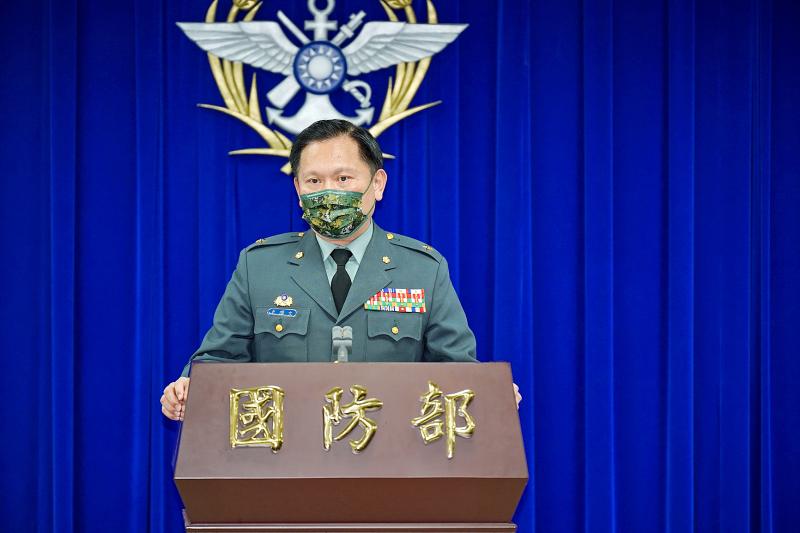The military yesterday confirmed media reports that multiple weather balloons used by the Chinese military passed over the country shortly after the Lunar New Year holiday, but said the balloons posed no security threat and were being used for meteorological observations.
“The air force has full understanding of the [balloons’] movements. It is believed they were being be used for meteorological observations,” Ministry of National Defense (MND) spokesman Major General Shih Shun-wen (史順文) said.
Shih’s comments came after Chinese-language United Daily News on Saturday reported that an unspecified number of weather balloons in four groups were released from China’s Fujian Province by a long-range rocket unit of an artillery brigade from the Chinese People’s Liberation Army’s (PLA) 72nd Group Army.

Photo: Aaron Tu, Taipei Times
The balloons were detected by air force radar at altitudes from 2,743m to 3,048m above Keelung, Taoyuan and Hsinchu, shortly after the Lunar New Year holiday period, the report said.
The weather balloons raised concerns amid the Russian invasion of Ukraine and following President Tsai Ing-wen’s (蔡英文) request for the armed forces to remain on high alert, it said.
Even if the balloons were being used for military purposes, they were likely analyzing atmospheric density for the PLA’s Eastern Theater Command and pose no immediate security threat, Institute for National Defense and Security Research analyst Su Tzu-yun (蘇紫雲) said yesterday.
Meanwhile, the MND yesterday posted a video on Facebook to show that the armed forces have increased patrols and strengthened combat preparedness to deter China from attacking Taiwan.
“The military has continued to step up surveillance as it remains alert and closely observes military activities across the Taiwan Strait. We are determined and capable of defending the country,” the ministry said in the video.

US climber Alex Honnold is to attempt to scale Taipei 101 without a rope and harness in a live Netflix special on Jan. 24, the streaming platform announced on Wednesday. Accounting for the time difference, the two-hour broadcast of Honnold’s climb, called Skyscraper Live, is to air on Jan. 23 in the US, Netflix said in a statement. Honnold, 40, was the first person ever to free solo climb the 900m El Capitan rock formation in Yosemite National Park — a feat that was recorded and later made into the 2018 documentary film Free Solo. Netflix previewed Skyscraper Live in October, after videos

Starting on Jan. 1, YouBike riders must have insurance to use the service, and a six-month trial of NT$5 coupons under certain conditions would be implemented to balance bike shortages, a joint statement from transportation departments across Taipei, New Taipei City and Taoyuan announced yesterday. The rental bike system operator said that coupons would be offered to riders to rent bikes from full stations, for riders who take out an electric-assisted bike from a full station, and for riders who return a bike to an empty station. All riders with YouBike accounts are automatically eligible for the program, and each membership account

NUMBERS IMBALANCE: More than 4 million Taiwanese have visited China this year, while only about half a million Chinese have visited here Beijing has yet to respond to Taiwan’s requests for negotiation over matters related to the recovery of cross-strait tourism, the Tourism Administration said yesterday. Taiwan’s tourism authority issued the statement after Chinese-language daily the China Times reported yesterday that the government’s policy of banning group tours to China does not stop Taiwanese from visiting the country. As of October, more than 4.2 million had traveled to China this year, exceeding last year. Beijing estimated the number of Taiwanese tourists in China could reach 4.5 million this year. By contrast, only 500,000 Chinese tourists are expected in Taiwan, the report said. The report

Temperatures are forecast to drop steadily as a continental cold air mass moves across Taiwan, with some areas also likely to see heavy rainfall, the Central Weather Administration (CWA) said. From today through early tomorrow, a cold air mass would keep temperatures low across central and northern Taiwan, and the eastern half of Taiwan proper, with isolated brief showers forecast along Keelung’s north coast, Taipei and New Taipei City’s mountainous areas and eastern Taiwan, it said. Lows of 11°C to 15°C are forecast in central and northern Taiwan, Yilan County, and the outlying Kinmen and Lienchiang (Matsu) counties, and 14°C to 17°C